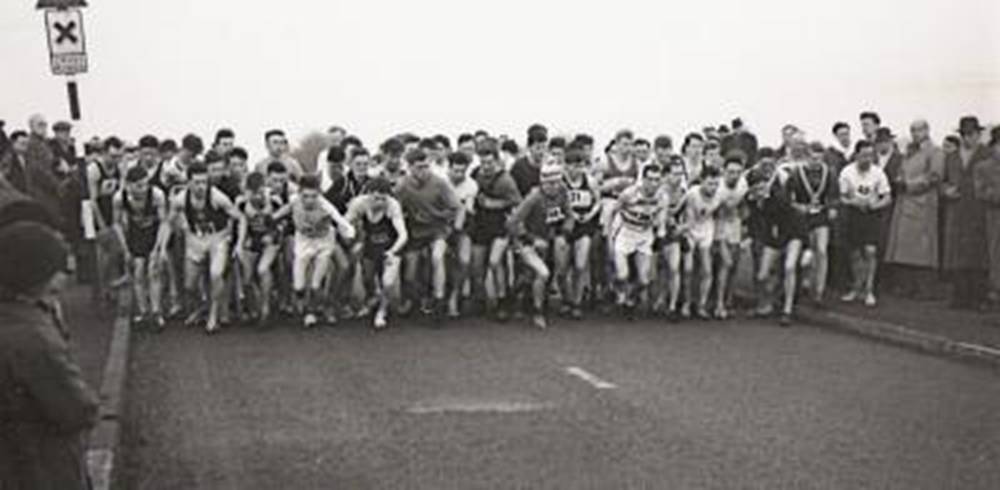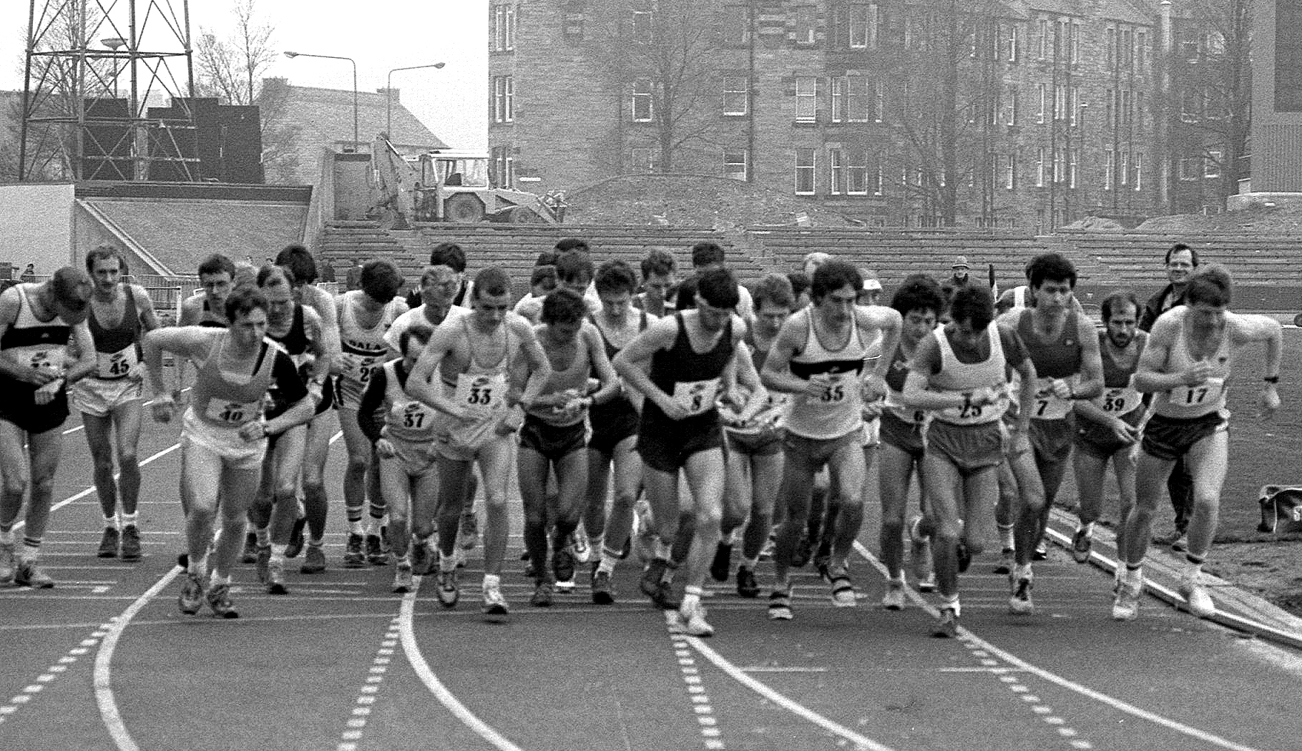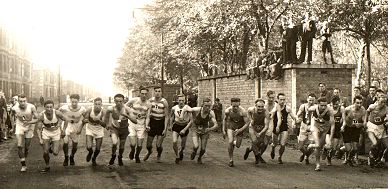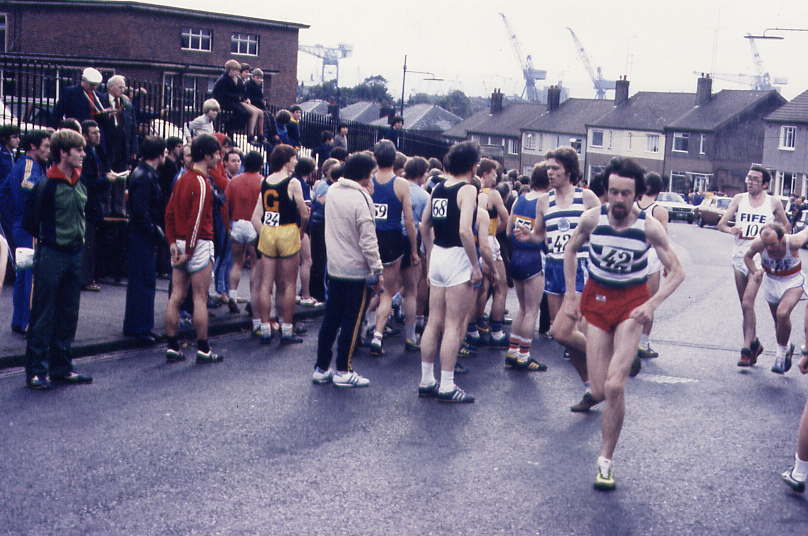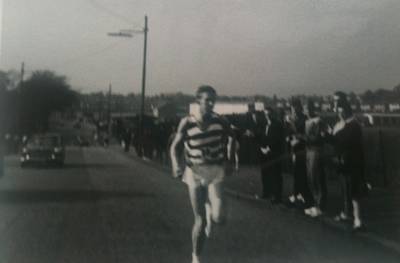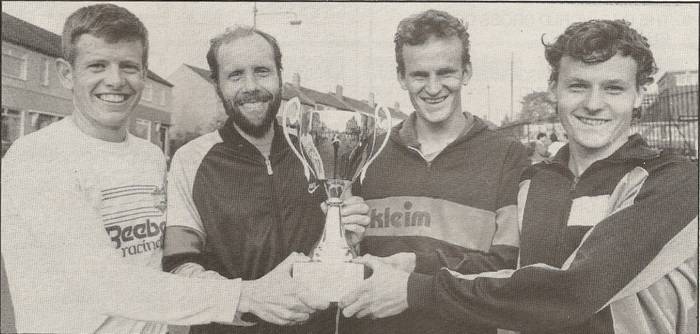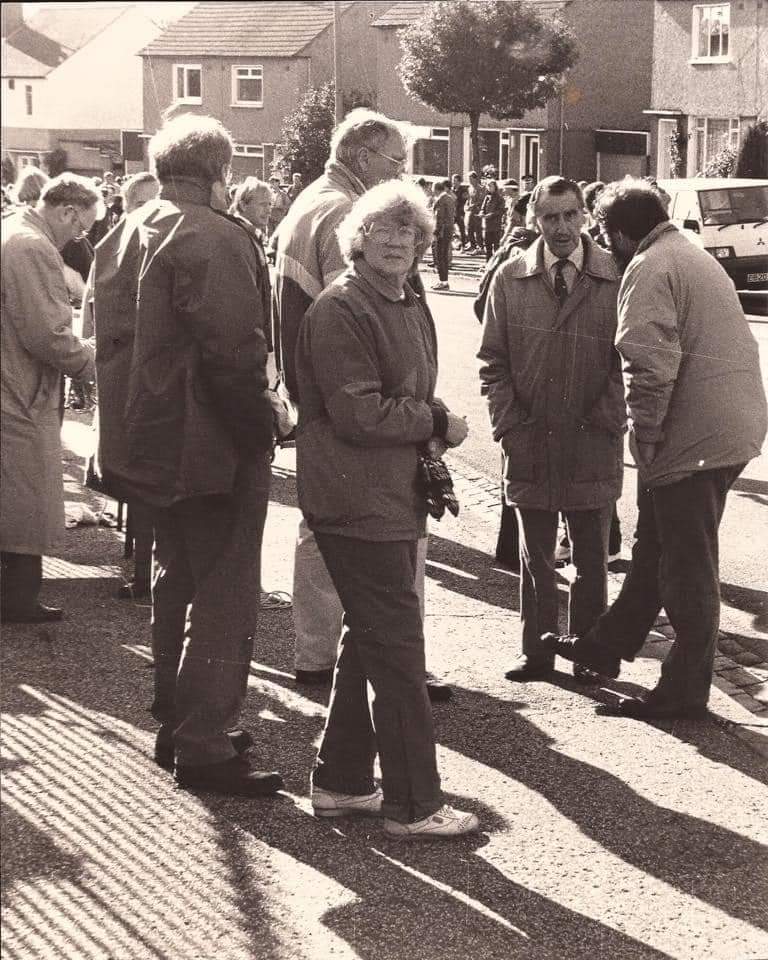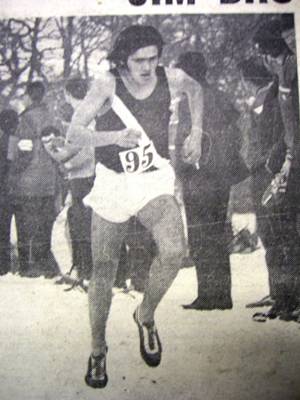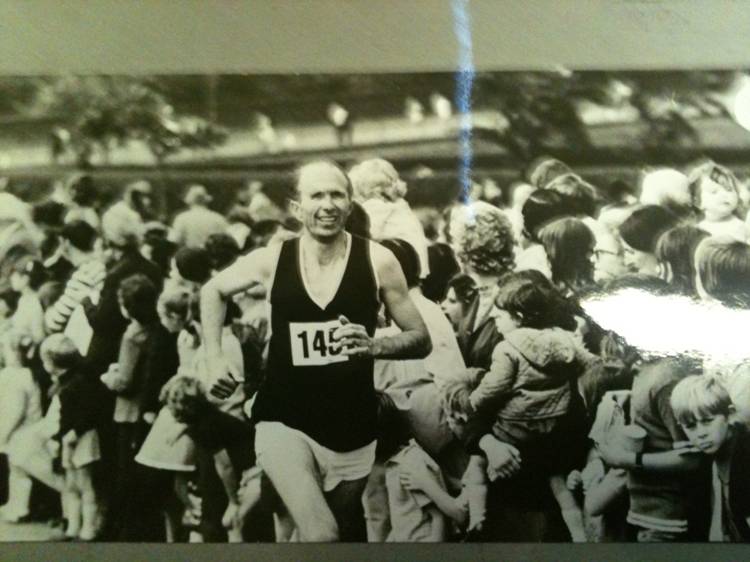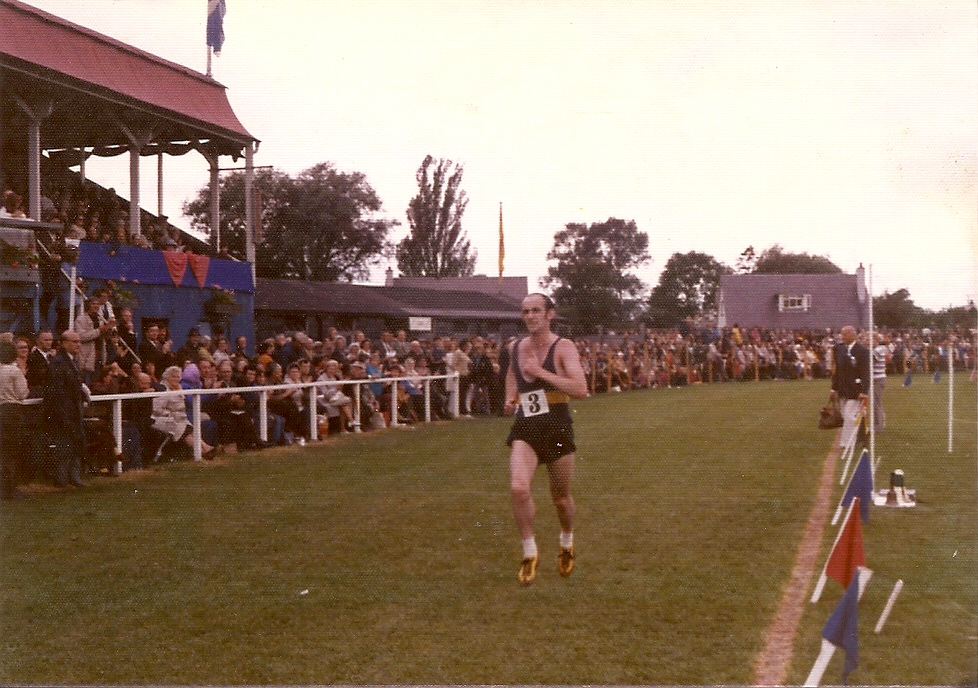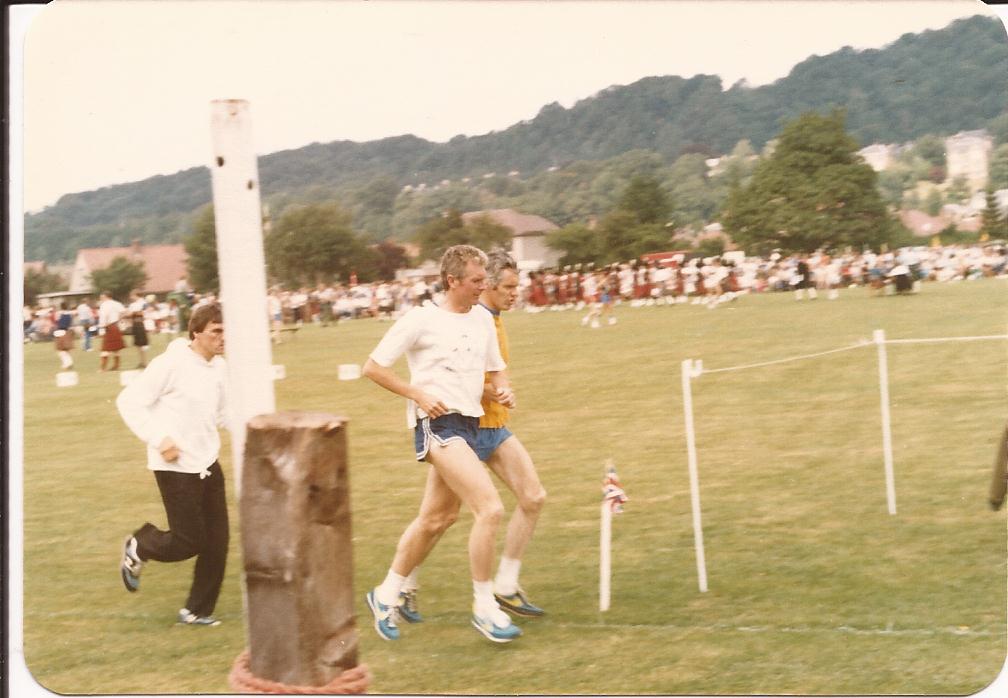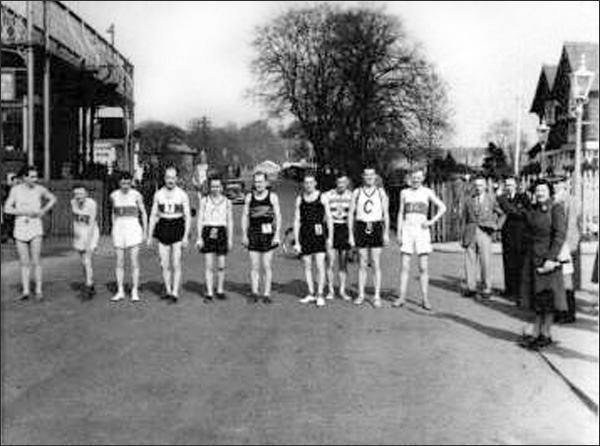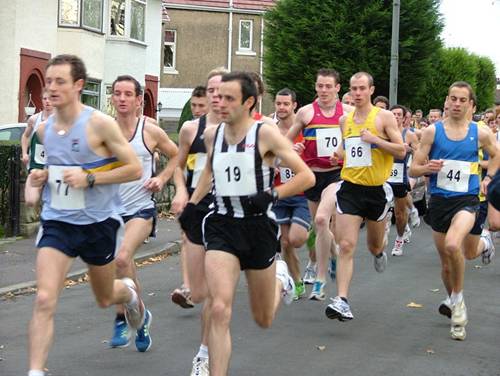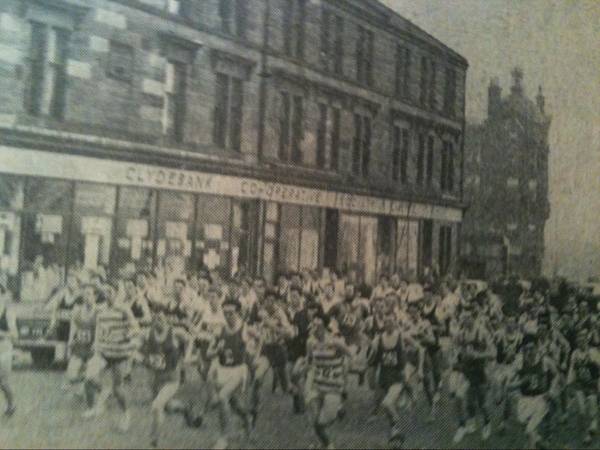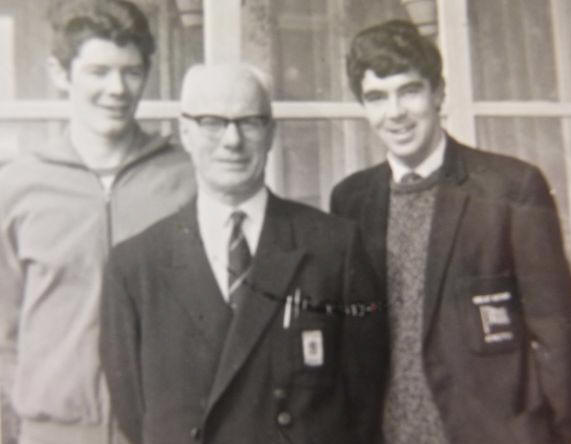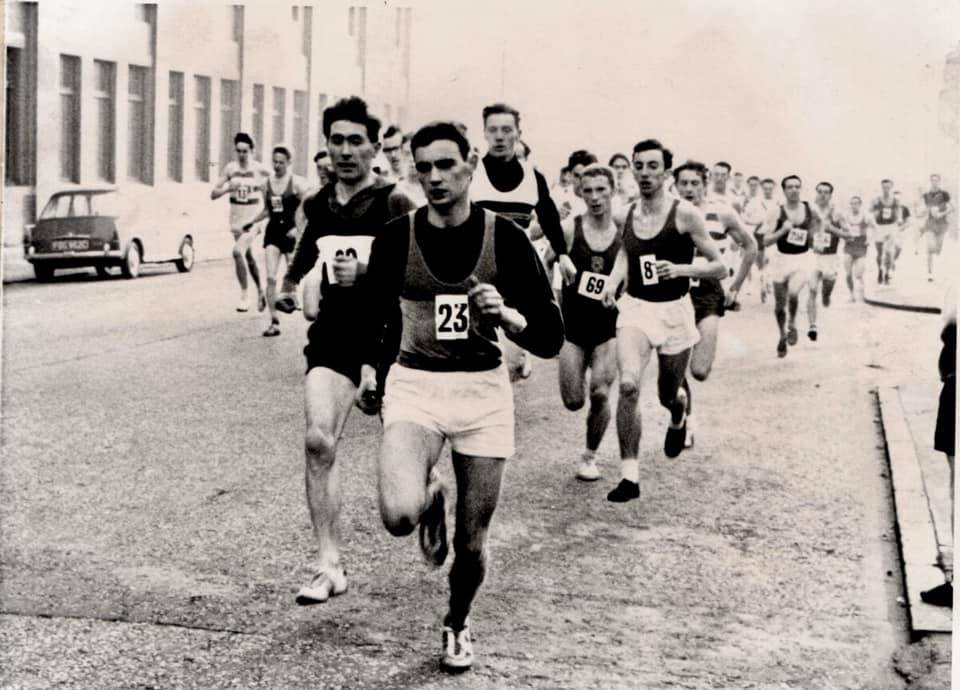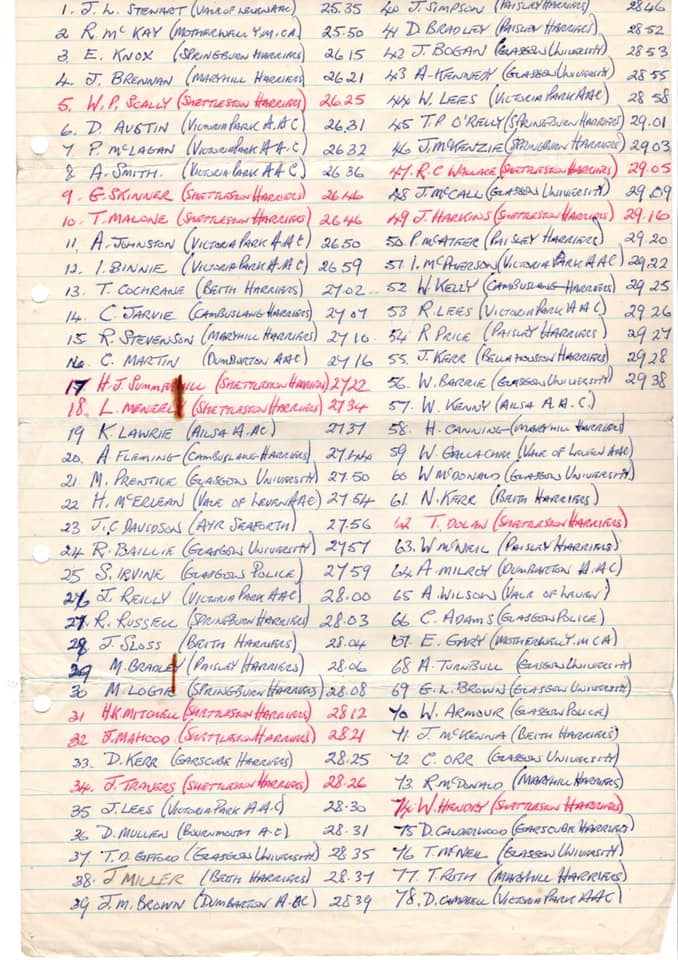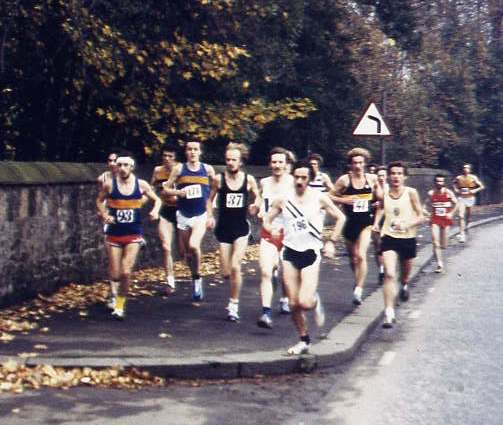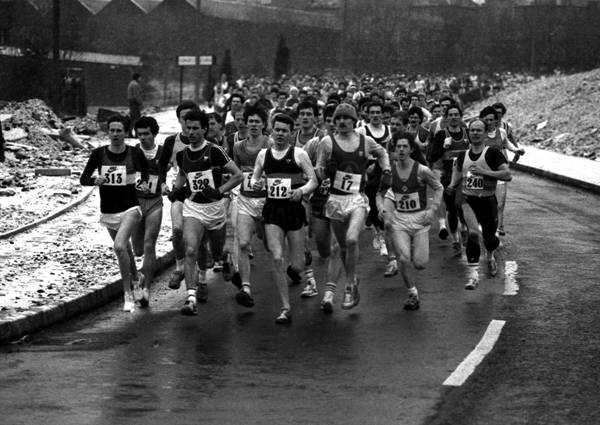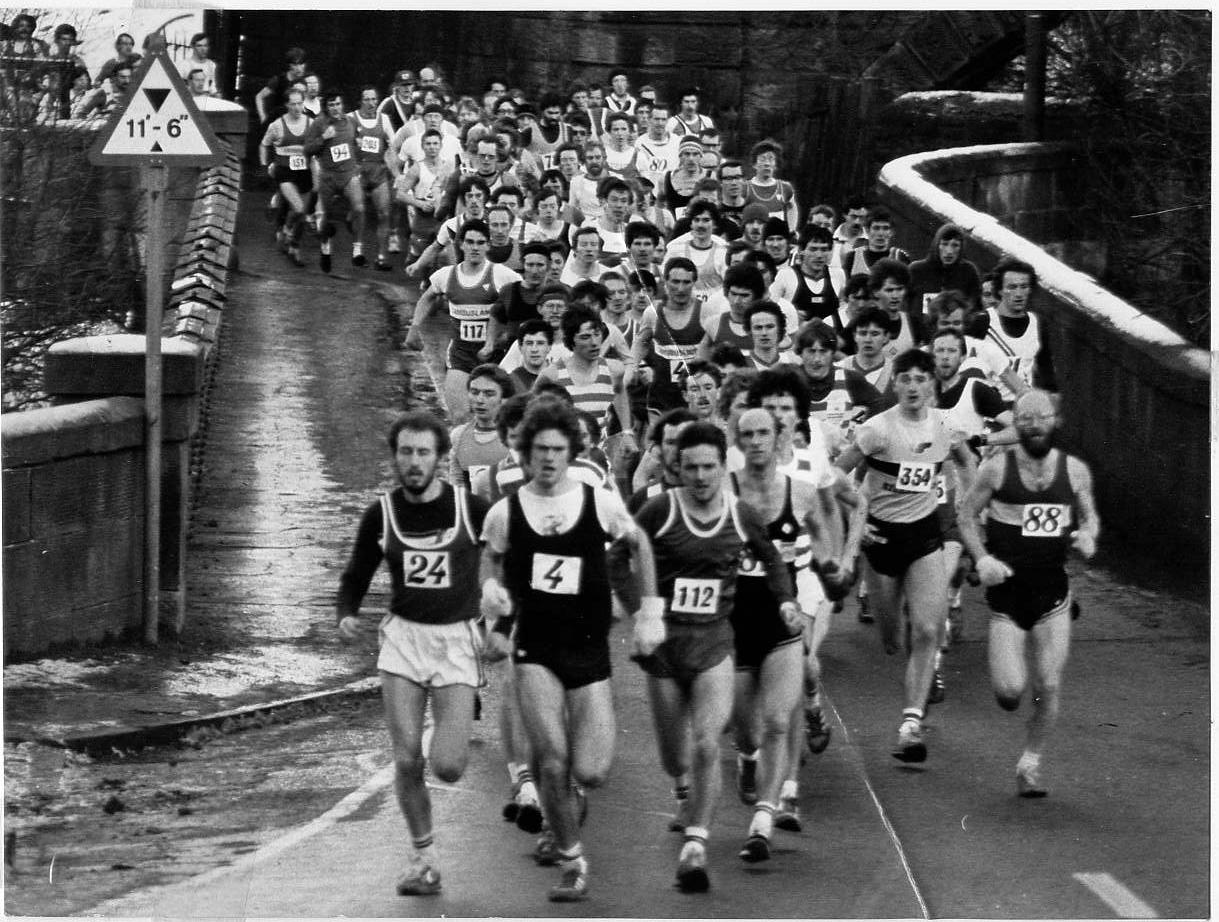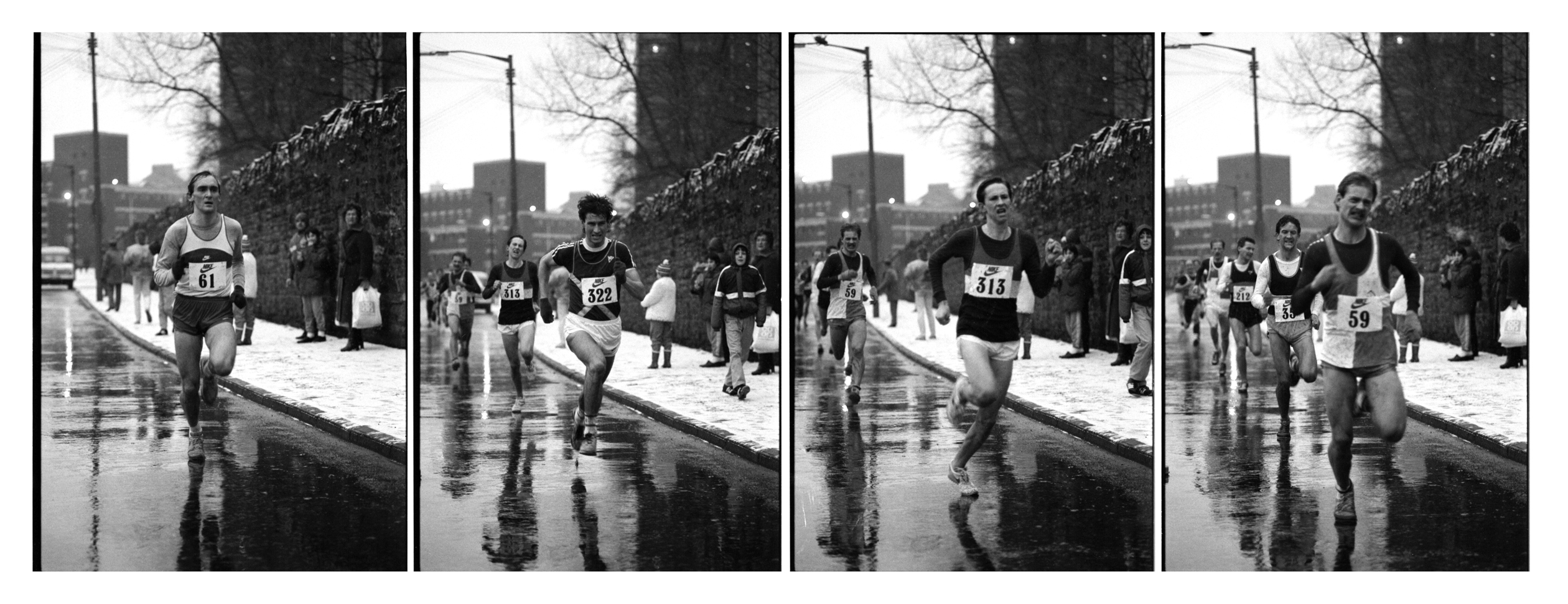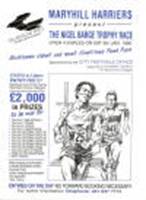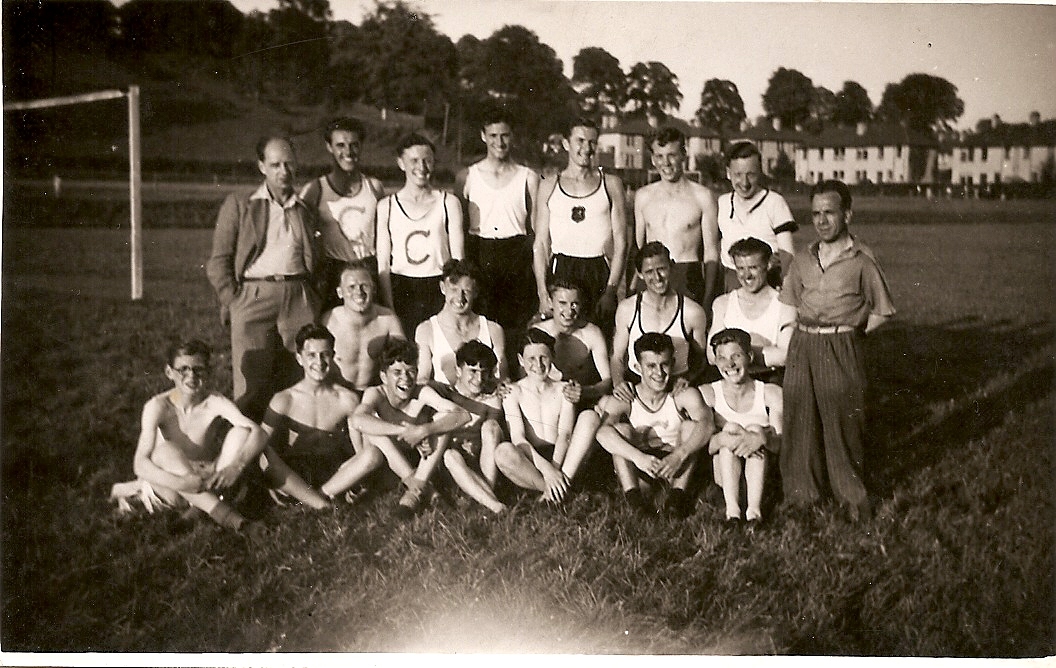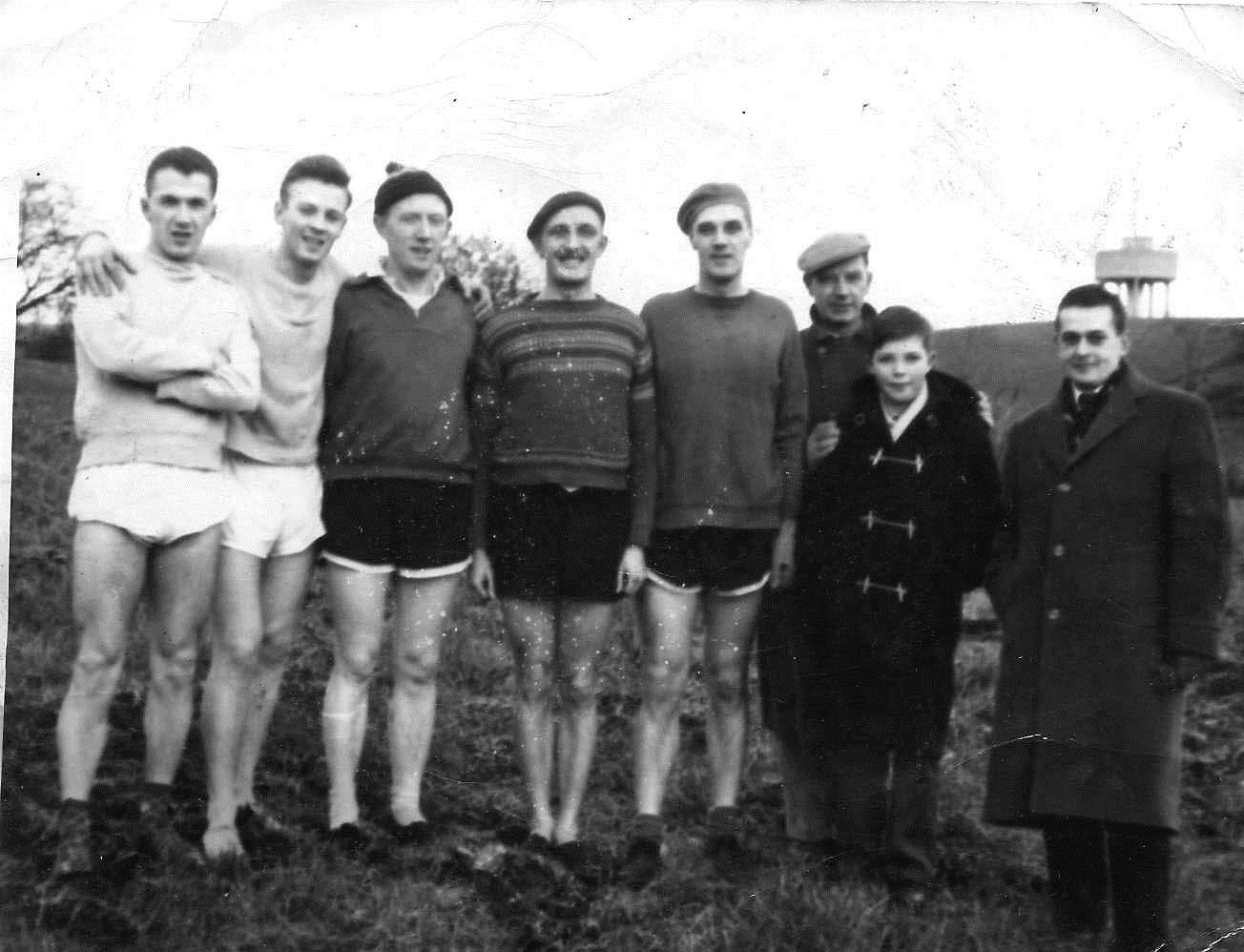Race Start in 1940’s: is it Andy Forbes in the front row?
The Beith New Year’s Day race was a fixture when I started running in 1957 but the problem was that, being on 1st January, and in Scotland, there was only skeleton public transport running. It being the 1950’s not many had cars of their own – so if you wanted to run there you needed a car of your own, you needed to know someone with a car who would take you or you had to hit it lucky with trains and/or buses. The thing is though that despite all those disincentives, the race was supported by international runners, Scottish champions and even Olympic athletes! Local international runners like Ian Harris and Tom Cochrane ran there, Olympians such as Lachie Stewart, Ian McCafferty, Suttie-Smith, Alex Breckenridge and more recently Lynne MacDougall, cross-country internationals like Lawrie Spence, Eddie Bannon, Andy Forbes, Jimmy Flockhart and Pat Moy, all travelled to Beith for the event. Started in the late 1920’s it is still going strong.
I first ran in it when it was a cross-country race and remember one point in the trail where the path ran straight into a burn – but to get back out required getting up on to a raised bank on the other side. Not easy. I remember once when it was a road race, Andy Brown seeing brother Alex doing some strides away from the start line when the field was getting in order. He called his young brother back and pointed out that they would not start the race if Alex was 50 yards down the trail in the direction of the race but they might if he were 50 yards behind the start line! Only the wording was more direct. I remember sitting beside Ian McCafferty in the changing room and him showing me the new shoes he had just got from Puma with things like suckers on the sole. In those days it was a men only affair but like most races now, it incorporates races for women and younger athletes are also catered for. Information below came mostly from Kenny Phillips and stats are mainly from Alex Wilson who has posted all the winners on the Association of Road Runners website at . https://arrs.run/HP_Kilbirnie4.htm.
Other than the Red Hose race at Carnwath in Lanarkshire it is said to be the oldest race in Scotland, being slightly ahead of the Balloch to Clydebank race in Dunbartonshire. Alex Wilson says that he thinks the race dates from 1926 but the results start at 1929
It was always held on 1st January except when that fell on a Sunday when the race was run on the 2nd January. What I would like to do is look at the winners and show how the standard that was high at the start has been maintained – the Emsley Carr Mile in London has a book in which the winners write their name. Had such a book been started for the Beith races, then with all the signatures that would have been collected in it, you would have had a very valuable document.
Pre-War Race Winners
| Date | Winner | Club | Time | Distance |
| 1st January 1929 | J Suttie Smith | Dundee Thistle H | 40:48 | 6.5 Miles |
| 1st January 1930 | S Tombe | West of Scotland H | 39:40 | 6 Miles |
| 1st January 1931 | CP Wilson | Irvine YMCA H | 38:42 | “ |
| 1st January 1932 | Maxwell Stobbs | Catrine H | 33:35 | “ |
| 1st January 1933 | J Flockhart | Shettleston H | 5 Miles | |
| 1st January 1934 | J Campbell | Bellahouston H | 25:50 | 5 Miles |
| 1st January 1935 | J Flockhart | Shettleston H | 25:35 | 5 Miles |
| 1st January 1936 | J Flockhart | “ | 33:34 | 6 Miles |
| 1st January 1937 | P Allwell | Beith H | 32:56 | 6 Miles |
| 1st January 1938 | P Allwell | “ | 12:35 | 2.5 Miles |
| 1st January 1939 | M Barr | Beith H | 24:35 | 4.5 Miles |
| 1st January 1940 | A McGregor | Plebeian H | 20:15 |
The first of these, John Suttie Smith was an OIympic 10000m runner who ran in the Amsterdam Games in 1928 where he finished tenth in 31:50. He had best times of 14:41.2 for Three Miles, 15:22.6 for 5000n, 20:24.8 for Four Miles, 30:47 for Six Miles and 51:37.8 for Ten Miles (set in 1929). An Olympian in 1928 who set a personal best for Ten Miles in 1929, he was clearly at the top of his game when he won the Beith New Year’s Day Race. He also won the Scottish Cross-Country title five times (1928, ’29, ’30, ’31, ’32). The other notable in the pre-war victors list was of course Jimmy Flockhart of Shettleston Harriers who won the World Cross Country Championship in 1937 and the Scottish championship four times (1934, ’34, ’36 and ’37). Of the others, Sammy Tombe ran in the International Cross-Country Championships in 1928, 1933 and 1934, CP Wilson ran in them in 1928 and 1931, Stobbs in 1930, 1931 and 1932, Campbell in 1935 and 1936 and Allwell in 1936 and 1939.
The distance was much longer prior to 1937 than it has been since and the following report from the local paper in 1934, received from Kenny Phillips, maybe explains its early popularity. “Beith Harriers open ballot team race was held on Monday. This event is now recognised as a means of identifying form for the Scottish National Championships in March, and this year it was of particular interest at the International Championship is being held in Scotland, the venue being Ayur Racecoure. Conditions on Monday morning were all against the prospect of a good entry or a good race. However the weather cleared a bit in the afternoon and fully 35 runners faced the starter, Mr Wm Johnstone. These runners were balloted into nine teams comprising four to run, three to count. The ground conditions were none too good, but as it subsequently showed, this did not deter the keenness of the runners or spectators. That this race is a much-looked-for one on Ne’erday can be taken for granted by the number of people who were present at the start, and who followed the race from advantageous positions on the course. The trail, which was laid and marked out under the careful eye of TJ McAllister, differed from the one usually used for this race but which was excellently laid out from the spectator’s point of view, as one could see almost three-fourths of the race. This is an unusual thing in a cross-country race and was fully appreciated by the spectators, who took advantage of the many viewpoints to follow the course of the runners.
The runners were got off to a good start by Mr Johnstone, and J Campbell (Bellahouston H) quickly took the lead, followed by G Ferguson (Beith and Gala H), J Gifford (Victoria Park) and HW Davidson (Eglinton H). After almost a mile had been covered, J Campbell had established a lead of 30 yards from Gifford with Davidson and J Anderson (Lochwinnoch H) close behind. Then came DE Thomson (Victoria Park), J Millar (Beith H) and G Hunter (Bellahouston H). On completing the first circuit, J Campbell had increased his lead on Gifford, while Davidson had also lost ground, although still lying third. These were followed by J MIllar (Beith) who was beginning to move up and who was receiving plenty of encouragement on passing the crowd of interested spectators. At the four mile stage, it was easily seen that that it was going to be Campbell’s race unless anything unexpected happened. He was now leading by about 100 yards from Gifford with Jack Millar 30 yards further behind. The field was still strung out by this time and there was a difference of almost five minutes between first and last. At the finish there were no chages in the first three positions although J Millar made a valiant effort to get the better of Gifford but just failing. J Campbell (who is a previous winner of this race) won easily and proved to be a popular victor with the spectators who had followed his forcing race with interest and he was given a warm reception on finishing as were second and third.”
The report is of interest for several reasons, not least being the fact that the Ayrshire spectators were so interested or so appreciative of the winner’s efforts. The fact that it was used as a guage of form for the National is of interest as there was not nearly as full a calendar then as there is now and there were many inter-club runs to fill the gaps. A race over the approximate championship distance on the country would prove fairly popular. The fact that it was a ‘spectator friendly’ trail is well ahead of the time too – even in the 1960’s trails often consisted of one large nine mile loop with the officials watching the runners disappear into the distance before going to shelter in a building or car and having a cup of tea!
*
There was a wee hiatus between 1941 and 1949 for obvious reasons and Kenny Phillips has this to say about the restart of the race in ’49:
“At the Committee Meeting on 5/2/48 it was proposed to re-establish the New Year Day race to celebrate the 25th Anniversary of the club. The race would be a Ballot Team Race to give everyone a chance of a prize over 2.5 miles of road with three sets of team prizes. At the AGM on 7/9/48 the Secretary reported on the successful road race of 2.5 miles for Novices won by H Fenion of Lochwinnoch in the fast time for a Youth of 13 mins 03 secs. Harry went on to become Scottish marathon champion and Beith were disappointed that he did not join Beith Harriers instead of Bellahouston Harriers.
In the first postwar 1949 Ballot Team Race over 2.5 miles, there were 35 runners with Andy Forbes first in 13 min 24 sec, 180 yards in front of R Climie, Bellahouston, second, J Reid West Kilbride third, and the novice T McNeish, Irvine, fourth. The first ballot team was W Ritchie Victoria Park, B Hainey, Doon, and J Ellis of Victoria Park 11th. The first prize was an oak occasional table donated by the Co-operative Furniture Factory in Beith, and the first team prizes were three mahogany tea trays made by Jack Millar, the 1929 Novice Champion.”
Kenny also believes that the race was probably cross-country until about 1990 when it was changed to road After the war it was planned as a two lap, four mile cross-country course. However in 1949 due to severe frost, it was dangerous underfoot and the course was changed to a 2.5 mile road which Andy Forbes won wearing spikes on the slippy road surface.
Andy went on to win the race in 1950 and 1951. The Ballot Team format was fairly popular at the time. It was meant to address what was seen as a problem, or if not a problem, a basic case of fairness in the winning of team prizes. In all the main races – National, District and County as well some open races, the same clubs won every time out with other good standard athletes missing out time after time. The solution was to place the names of all entries into a hat and draw out three or four names at random, these to form Ballot Team 1, then three or four more to form Ballot Team 2 and so on. Even when I started in the sport in the 1960’s I ran in several events where the format was used – Garscube was one such, but the biggest race of the type that I competed in was the Balloch to Clydebank 12 Miles Race. By winning the race three times, Andy was one of several multi-winners.
Post War Race Winners
| Date | Winner | Club | Time | Distance |
| 1st January 1949 | Andy Forbes | Victoria Park | 13:24 | 2.5 Miles |
| 1st January 1950 | “ | “ | 20:57 | 2.5 Miles |
| 1st January 1951 | “ | “ | 4 Miles | |
| 1st January 1952 | – | – | – | – |
| 1st January 1953 | Alex Breckenridge | Victoria Park | 20:17 | 4 Miles |
| 1st January 1954 | Eddie Bannon | Shettleston H | 20:37 | 4 Miles |
| 1st January 1955 | Andy Brown | Motherwell YMCA | 20:46 | 4 Miles |
| 1st January 1956 | “ | “ | 19:38 | 4 Miles |
| 1st January 1957 | Pat Moy | Vale of Leven | 20:34 | 4 Miles |
| 1st January 1958 | Alex Breckenridge | Victoria Park | 20:40 | 4 Miles |
| 1st January 1959 | W Thomas | Irvine YMCA | 21:34 | 4 Miles |
Andy Forbes was of course a Scottish and British Internationalist on the track with multiple Scottish selections on the country to his credit with the high spot maybe being the silver medal in the Empire Games in 1950. He also won the Scottish Cross-Country Championship twice. Alex Breckenridge was also a Scottish internationalist who emigrated to the United States and represented them as a marathon runner. Andy Brown, Scottish track, road and country Internationalist who was one of the most inspiring of captains and was in fact Scottish International team captain for many years. Eddie Bannon was a superb athlete on every surface and won the Scottish championship four times (1952, ’53, ’54 and ’56) and had seven appearances in the International race. Pat Moy from the Vale of Leven represented Scotland in the International CC Championships in 1956, 1957 and 1958 so he too was clearly a top class man for a considerable period with the Beith win being right in the middle of his three year purple patch. Clearly the race had some status when men of such high calibre came year after year on New Year’s Day to contest it.
Results from the Sixties
| Date | Winner | Club | Time | Distance |
| 1st January 1960 | Pat Moy | Vale of Leven | 20:31 | 4 Miles |
| 2nd January 1961 | Ian Harris | Beith Harriers | 21:03 | 4 Miles |
| January 1962 | – | – | – | – |
| 1st January 1963 | Lachie Stewart | Vale of Leven | 22:56 | 4.5 Miles |
| 1st January 1964 | Ian McCafferty | Motherwell YMCA | 20:59 | 4 Miles |
| 1st January 1965 | Andy Brown | “ | 20:25 | 4 Miles |
| 1st January 1966 | Ian McCafferty | “ | 21:33 | 4 Miles |
| 2nd January 1967 | “ | “ | 18:58 | 4 Miles |
| 1st January 1968 | Alastair Johnston | Victoria Park | 24:48 | 4.5 Miles |
| 1st January 1969 | Dick Wedlock | Shettleston H | 19:58 | 4 Miles |
Ian Harris was a first rate athlete who won the SAAA Marathon in 1963 as well as being a cross-country internationalist and – unfortunately for Scottish athletics – did most of his running in the colours of the Parachute Regiment all over the world. Lachie Stewart and Ian McCafferty were both multi SAAA champions and Olympians too. Lachie won the first ever SCCU Boys championship and won the Senior race in 1967 and 1968 while Ian won the Senior event in 1972 and had as one cross-country high point the third place in the international championship at Clydebank in 1969. Alastair Johnston won several Scottish International representative honours and would undoubtedly have won many more had he not been involved in the dreadful accident with the stray hammer at Meadowbank. One of the interesting features of the 1960’s was the introduction of age-group races in 1967. Although the quality of runner was high, the numbers were not fantastic at this point and this move proved a success. Lawrie Reilly of VPAAC won the junior boys race with Lawrie Spence fifth.
Winners from the 1970’s
| Date | Winner | Club | Time | Distance |
| 1st January 1970 | Dick Wedlock | Shettleston Harriers | 19:48 | 4 Miles |
| 1st January 1971 | Henry Summerhill | Shettleston Harriers | 4 Miles | |
| 1st January 1972 | Dick Wedlock | Shettleston Harriers | 19:56 | 4 Miles |
| 1st January 1973 | ||||
| 1st January 1974 | Lachie Stewart | Shettleston Harriers | 4 Miles | |
| 1st January 1975 | Jim Thomson | Law & District AAC | 21:39 | 4 Miles |
| 1st January 1976 | ||||
| 1st January 1977 | Jim Golder | Ayr | 30:37 | 6 Miles |
| 1st January 1978 | Hugh Forgie | Law & District AAC | 6 Miles | |
| 1st January 1979 |
It is not just the Beith races that have some gaps in the results for the 70’s and 80’s – I find a similar story in several other well-established races and I don’t know why this is the case. There are also a number of Classic Races where the actual trophy has ‘disappeared’. Results to fill in the gaps would be welcome. The standard remained high though. Dick Wedlock with three wins (1969, ’70 and ’72) was also a track internationalist (10000m at the 1970 Commonwealth Games) and won the Scottish Cross-Country title in 1969. Jim Thomson was a very good runner but one whom many people thought could have been a great talent had he stayed with the sport. Hugh Forgie and Jim Golder were in the main track runners who both gained Scottish selection for their preferred events of 800m and 1500m
Winners of the 80’s
| Date | Winner | Club | Time | Distance |
| January 1980 | ||||
| January 1981 | ||||
| January 1982 | Lawrie Spence | Shettleston H | ||
| January 1983 | Lawrie Spence | Shettleston H | ||
| January 1984 | Lawrie Spence | Shettleston H | 23:07 | 4.5 Miles |
| January 1985 | Lawrie Spence | Shettleston H | 22:06 | 4.5 Miles |
| January 1986 | Tommy Murray | Greenock Glenpark H | 23:41 | 4.5 Miles |
| January 1987 | Chris Robison | Spango Valley AAC | 22:34 | 4.5 Miles |
| January 1988 | Graeme Croll | East Kilbride AAC | 23:33 | 4.5 Miles |
| January 1989 | Paul Larkin | England | 23:53 | 4.5 Miles |
If we concentrate on the winners from this decade, Lawrie Spence of Greenock Glenpark, Shettleston Harriers, Spango Valley and Inverclyde stands out as one of the all-time greats of the sport. A sub-four miler he also ran well under 2:20 for the marathon and captained the Scottish International Cross-Country team after Jim Alder ended his reign in that post. One of five brothers, there seemed to be no event to which he could not turn his hand and he is now a very good coach indeed with Inverclyde AAC. Graeme Croll was perhaps a bit unfortunate that he was steeplechasing at the same time as Tom Hanlon but he won more than his share of SAAA titles including the steeplechase and 10000m on consecutive days! Tommy Murray and Chris Robison were two thirds of a triumvirate that was to dominate Scottish long distance running in the 90’s – both represented their country on the track, over the country, on the roads and in World Mountain Running championships. Chris also represented England in the world event before he transferred allegiance to become on of the Scottish stars of the 90’s. Paul Larkin was a member of Wolverhampton and Bilston AAC who could also turn his hand to most events on the track, road and country and represented England in the World Cross Country Championships. The standard was still incredibly high for the Beith New Year’s Day Race.
Winners in the 90’s
| Date | Winner | Club | Time | Distance |
| January 1990 | Tommy Murray | Greenock Glenpark H | 22:35 | 4.64 Miles |
| January 1991 | Tommy Murray | Cambuslang H | 23:30 | 4.64 Miles |
| January 1992 | Chris Robison | Spango Valley AAC | 21:55 | 4.64 Miles |
| January 1993 | Glen Stewart | ESH | 22:57 | 4.64 Miles |
| January 1994 | Glen Stewart | “ | 23:02 | 4.64 Miles |
| January 1995 | Tony Johnston | Irvine | 22:23 | 4.64 Miles |
| January 1996 | Colin Brash | Girvan AAC | 23:57 | 4.64 Miles |
| January 1997 | Alan Puckrin | Kilbarchan | 23:11 | 4.64 Miles |
| January 1998 | David Gardiner | Racing Club | 24:08 | 4.64 Miles |
| January 1999 | Jamie Reid | Law & District AAC | 24:10 | 4.64 Miles |
Glen Stewart is the son of Lachie Stewart – the only father and son double act to win the Beith race – and was a very good track runner being the first British athlete to finish in the Commonwealth Games in Manchester in the 10000m as well as representing Scotland in the 5000m. Glen ran for many clubs but as a senior he ran in the main for the various incarnations of Racing Club in Edinburgh after a short spell with ESH. He has won the National Cross-Country title twice – in 2002 and 2004. Tony Johnston was another track runner – English and so unable to represent Scotland but a credit to himself and his club in every race he turned out in. Alan Puckrin was one of the few Scottish cross-country runners to get his picture on the front of Athletics Weekly. A cross-country and track internationalist of some stature he was friendly and outgoing and a popular winner. David Gardner won many medals as part of the Racing Club in Edinburgh and had the international championship been open to Scotland as it had been before the world body forced the amalgamation, he was one who would probably have gained selection. Jamie Reid of Law & District was a very good marathon runner (see his profile on the Marathon Stars page) who could also run on country and track and who represented his country.
Winners in the 00’s
| Date | Winner | Club | Time | Distance |
| January 2000 | Jamie Reid | Law & District | 22:49 | 4.64 Miles |
| January 2001 | Tommy Murray | Inverclyde AAC | 22:46 | 4.64 Miles |
| January 2002 | Billy Richardson | Irvine AAC | 23:31 | 4.64 Miles |
| January 2003 | Mark Pollard | Inverclyde AAC | 24:34 | 4.64 Miles |
| January 2004 | Jamie Reid | Cambuslang Harriers | 23:06 | 4.64 Miles |
| January 2005 | Chris MacKay | Greenock Glenpark H | 23:25 | 4.64 Miles |
| January 2006 | “ | “ | 23:20 | 4.64 Miles |
| January 2007 | “ | “ | 22:44 | 4.64 Miles |
| January 2008 | David Millar | Irvine AAC | 23:12 | 4.64 Miles |
| January 2009 | Ross Toole | Kilbarchan AAC | 23:00 | 4.64 Miles |
Tommy Murray is still in there – his first victory was in 1986 and there he is winning again in 2001. Tommy is also a very friendly guy but does not suffer fools gladly and has had some run-ins with authority in his career – he gets on fine with fellow runners though. Tommy also has four wins in the National Cross-Country Championship – in 1989, ’91, ’92 and ’93. Jamie Reid has two more victories here and if you look at his profile, you will see that he is indeed a worthy winner. Billy Richardson is another who is unfortunate not to have been racing when Scotland was a separate country in the world championships because he would have had several vests. As it was, he was unfortunate to have been running at the same time as the Quinn, Robison and Murray group. This decade in the results of the race, as indeed all of them, reflects the situation in Scottish athletics. The dominant clubs are no longer Victoria Park, Bellahouston Harriers or Shettleston Harriers – it’s the clubs from South of the Clyde that are coming to the fore. Tommy Murray is a Greenock boy and Mark Pollard and Chris MacKay are two of a wonderful group of young distance runners at Inverclyde AAC coached by Lawrie Spence and Norrie Hay. Mark has won the Scottish Cross-Country title twice already (2007, ’08) and Chris has been a close-up member of National winning teams. These guys still have a lot to give the sport. Ross Toole is an excellent young prospect from Kilbarchan who seem to specialise in whole dynasties of athletics talent – the Hawkins brothers are as famous as the three generations of the Toole family. I’ll bring the results up-to-date but reserve the comments until January 2019!
| Date | Winner | Club | Time | Distance |
| January 2010 | Race | Cancelled | Snow & | Ice |
| January 2011 | Chris MacKay | Inverclyde AAC | 22:43 | 4.64 |
| January 2012 | Stuart Gibson | Cambuslang Harriers | 23:55 | 4.64 |
It is a popular race and whatever its secret, lots of runners keep coming back and several have been multi-race winners. Most prolific was Tommy Murray with four (1986, ’90, ’91 and 2001) as had Chris McKay of Inverclyde (2005, ’06, ’07 and possibly 2011), Chris MacKay (2005, ’06, ’07 and’11) and Lawrie Spence (1982. ’83, ’84 and ’85) with several on three each – Jim Flockhart (Shettleston) in 1934, ’35, ’36), Ian McCafferty (1964, ’66 and ’67) and Dick Wedlock (1969, ’70 and ’72) while on the women’s side Susan Finch (City of Glasgow) won three in 2006, ’07, ’08 and Ann Ridley (McLaren City of Glasgow) in 1987, ’88 and ’89.
The Women’s Race
| Date | Winner | Club | Time | Distance | Date | Winner | Club | Time | Distance | |
| January 1984 | Carol Devlin | 18:30 | 2.5 | January 1999 | Shona Hughes | 29:04 | 4.64 | |||
| January 1985 | Marcella Robertson | ESH | 18:11 | 2.5 | January 2000 | Jill Cox-Knowles | City of Glasgow | 28:42 | 4.64 | |
| January 1986 | “ | ESH | 25:54 | 4.5 | January 2001 | Ann Hay | Greenock Glenpark Harriers | 24:28 | 3.48 | |
| January 1987 | Ann Ridley | McLaren Glasgow | 27:01 | 4.5 | January 2002 | D Sancil | USA | 23:47 | 3.48 | |
| January 1988 | “ | “ | 27:35 | 4.5 | January 2003 | Liz McGarry | Irvine AC | 24:34 | 3.48 | |
| January 1989 | Elspeth Turner | Glasgow AC | 27:54 | 4.5 | January 2004 | Claire Gibson | Kilbarchan AAC | 27:51 | 4.64 | |
| January 1990 | Ann Ridley | “ | 26:37 | 4.64 | January 2005 | Claire McCracken | City of Glasgow | 27:15 | 4.64 | |
| January 1991 | Helen Morton | Irvine | 22:01 | 3.48 | January 2006 | Susan Finch | City of Glasgow | 27:54 | 4.64 | |
| January 1992 | Lynne MacDougall | City of Glasgow | 25:34 | 4.64 | January 2007 | Susan Finch | City of Glasgow | 27:48 | 4.64 | |
| January 1993 | S Kennedy | Victoria Park | 28:22 | 4.64 | January 2008 | Susan Finch | City of Glasgow | 28:04 | 4/64 | |
| January 1994 | Sharon Hatch | Irvine AC | 13:09 | 4.64 | January 2009 | Kara Tait | Kilmarnock HAC | 29:45 | 4.64 | |
| January 1995 | 4.64 | January 2010 | Race | Cancelled: Weather | ||||||
| January 1996 | Helen Morton | Irvine AC | 30:41 | 4.64 | January 2011 | Claire Whitehead | Deeside Runners | 28:01 | 4.64 | |
| January 1997 | Jackie Byng | Irvine AC | 31:22 | 4.64 | January 2012 | Kara Tait | Kilmarnock HAC | 29:21 | ||
| January 1998 | Alison Higgins | JW Kilmarnock H | 27:56 | 4.64 |
As with the men, runners came from all over Scotland, and beyond in 2002. From Aberdeen in the north to Edinburgh in the East, from Greenock in the West but mainly from the Glasgow area with no fewer than 11 of the 27 races heading for the conurbation. Five from Irvine and three from Kilmarnock were the top clubs apart from that. Olympian Lynne MacDougall’s outstanding time of 25:34 for the 4.64 mile trail was clearly the performance of the series although the weather at this time of year can have a lot to do with watch times! Lynne was a real quality athlete with Scottish titles on the road, track and country and latterly as a marathon runner who only missed Games selection through injury. She would add lustre to any list of race winners. There are ,many well known names on this roster: Claire Gibson cruelly denied really major selections as an 800m track runner through unfortunate injuries at the wrong time, Marcella Robertson was also a well known orienteer as well as a top flight runner, Alison Higgins from Kilmarnock was a really good all round endurance runner who showed talent on the track and road as well as over the country. Jill Knowles was the daughter of Hammy Cox of Greenock Glenpark and grand-daughter of Bertie, a well-known road runner in the 50’s and 60’s who was a class runner in her own right. Many of the girls above could have won national cross-country titles but for the overwhelming dominance of Freya Murray who has won the Scottish Cross-Country Championship seven times in nine years! Susan Finch, running at present as a veteran has best times of 17:25 and 36:30 for 5K and 10K on the roads and 10:22.8 for 3000m indoors; Ann Ridley who equals Susan’s three victories was one of the best cross-country runners of her generation, and won the Scottish Cross-Country title in 1990. Elspeth Turner was a very good athlete who went on a scholarship to the University of Alabama and developed her talent even further – she has best times of 5000m on the track and 5K on the road of 16:11.09 and 18:25 and for 10000m track and 10K road of 33:05.43 and 37:43. Kara Tait has a range of personal bests ranging from 64.3 for 400m to 36:47 for 10K on the road – and she is still only 25 years old. All the women who have won the race in its short 28 years existence have been at least very good athletes at best of the very highest calibre.
